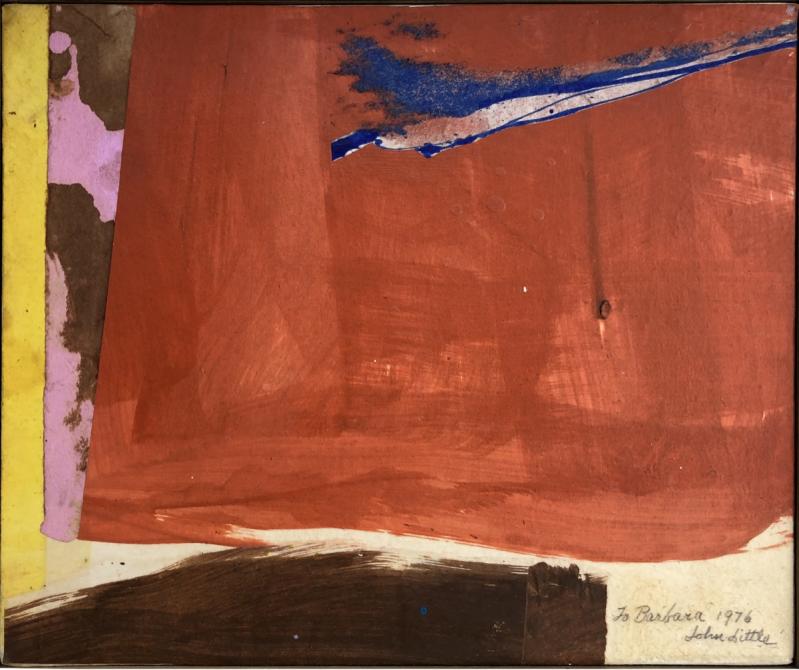By the time Jackson Pollock and Lee Krasner arrived in East Hampton in 1945, Pollock wasn't quite yet at the center of the art universe, but he and Krasner, his wife, were part of the nucleus of the New York art world.
In "Creative Exchanges," an exhibition that makes that case evidentially and viscerally apparent, the Pollock-Krasner House and Study Center in Springs uses the artists' address books to tell the story of their very wide circle of friends in all aspects of the arts.
As Helen Harrison, the center's director, notes in the foreword to the exhibition catalog, one of the couple's earliest checks drawn from a local bank was to the phone company. A phone, which they didn't need in a city where friends and family were close, was essential to their rural existence. It was also a link to "art dealers, critics, collectors, and curators on whom Jackson's career depended."
There are three surviving address books that establish those connections. They highlight the couple's contacts from the 1950s to the 1960s. James L. Bauer and Theresa E. Davis have built an art show around the artists mentioned in these books along with other creative people the couple knew.
The curators have gathered works that remind viewers how close they were to some of the most influential artists of their generation as well as others who were well regarded in their time but have since been forgotten or fallen out of style.
Their circle even included Nataraj Vashi and Pravina Mehta, who performed and taught Indian folk dances and classical dances of Ceylon, Java, and Bali around the country. The organizers traced the friendship to the couple's visit to Pollock and Krasner's friends Mercedes and Herbert Matter in 1948 and a subsequent summer rental in 1952. A recent concert in East Hampton celebrated the dancers' cultural contribution to the United States.
With that exception, the group represented is more homegrown. In the catalog, the artists have their own photos, photos of the artwork in the show, and phone number at the time. The numbers, as in movies from the 1940s, use exchanges like EA4 (East Hampton 4) or the more familiar 324. The letters match up to the numbers on the phone's dial, as "the kids today" can see on their cellphone's keypad. The catalog also has an essay by Tim Keane, and Patsy Southgate's reflections on the "Eastern Long Island Painters" published in the 1959 spring-summer edition of The Paris Review.
The installation pops with expressive use of color on relatively small canvases or sheets of paper that pack a nice wallop. An Adolph Gottlieb untitled "Burst" on a red ground in acrylic on paper dominates a dining room wall, with James Brooks's "Fandron," from 1972, holding its own on the opposite side in a mostly blue composition. The two very colorful works are balanced out by a Costantino Nivola sand cast from 1961 and a Helen Frankenthaler (who shows up in all three address books) painting made a year before she met Pollock and witnessed firsthand his creative process. The kind of abstraction in "Cloudscape," which is quite linear and painterly in nature, would soon be replaced by her soak-stain technique. A rusty and diminutive John Little work on paper hanging over the Brooks piece completes the tableau.
On nearby walls are a Paul Jenkins acrylic on canvas (Krasner was visiting Jenkins in Paris when she learned of Pollock's death back in Springs), a transitional Mark Rothko from 1945, and a replica of Barnett Newman's "Onement I." A small Wilfrid Zogbaum copper sculpture is placed on the credenza under the Rothko painting. On the dining table, the three address books sit in a vitrine, open to various pages.
The rest of the installation is similar, like near like, with unusual standouts in groupings or on their own. In the living room, there is a Thomas Hart Benton photogravure of a cowboy in Wyoming. It hangs with a Joseph Meert watercolor on paper from late in the artist's life. Meert was a student of Benton's and became friends with Pollock when both were studying with him. Fritz Bultman, whose painting completes the vignette, became friends with Krasner when both studied under Hans Hofmann.
Drawings by Philip Guston, Sanford McCoy (one of Pollock's brothers), and Reuben Kadish hang over the couch. There's a lovely wall back in the main room where Mercedes Matter and Vita Petersen works hang together over a vitrine containing a driftwood "Fish" by Betty Parsons, a record album by Vashi and Mehta, and other ephemera related to Pollock, Krasner, and their friends.
Certain objects, like a photograph of the couple by Hans Namuth and Ronald J. Stein's sculpture "Abraxas," are always on display, but feel especially relevant in this context. It underlines why they are there in a thoughtful and highly personal way, in the same manner the visiting works convey their relationship to the building and its former occupants.
The exhibition remains on view through July 30, and visits can be made by appointment on the center's website. Two talks on Zoom will take place before the show closes. On Sunday, Ms. Harrison will speak on "Bonac Bohemia: Artists of Springs." On the closing date, Henry Adams will discuss "Benton, Pollock, and the Secrets of El Greco." The free talks begin at 5 p.m., and registration can be made on the website.




